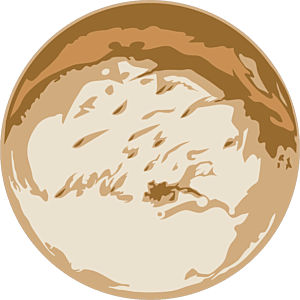The Downlink • Feb 09, 2024
Cool and mysterious
Space Snapshot

Meet Hyperion. This small moon of Saturn, shown here in an image from NASA’s Cassini spacecraft, is made up of about 40% empty space, giving it a sponge-like appearance. It’s one of our picks for the coolest lesser-known moons of Jupiter and Saturn. Image credit: NASA / JPL-Caltech / SSI.
Fact Worth Sharing

The Solar System is full of super cool moons, but in literal terms, the coolest of them all may be Triton. Neptune's icy moon is so bright that it reflects what little sunlight it receives. Its average surface temperature is about -240 degrees Celsius (-400 degrees Fahrenheit).
Mission Briefings


A potentially hazardous asteroid passed by Earth last week. The football field-sized asteroid, named 2008 OS7, flew past Earth on Feb. 2 at a distance of about 2.8 million kilometers (1.7 million miles). The asteroid is categorized as potentially hazardous because of its size and the proximity of its orbit to Earth’s. NASA was tracking the asteroid and expected its flyby. Pictured: Asteroid 2008 OS7 appears as a white dot on a starry background in this image by Gianluca Masi of the Virtual Telescope Project in Ceccano, Italy. Image credit: Gianluca Masi / The Virtual Telescope Project.

Rare, ancient meteorites have been found in Germany. Fragments of Asteroid 2024 BX1, which exploded over Germany on Jan. 21, have been collected and analyzed, showing that the rocks belong to a rare group called aubrites. Only 11 examples of this kind of meteorite have ever been found on Earth.

JPL has announced major layoffs. On Feb. 6, NASA’s Jet Propulsion Laboratory (JPL) Director Laurie Leshin announced layoffs of 530 people, roughly 8% of its full-time workforce, as well as 40 additional contract staff. The news comes on top of the 100 contractors let go last month. The Planetary Society’s chief of space policy explains why this has happened, and what it means for NASA space exploration.

A Moon mission is due to launch on Valentine's Day. The next mission in NASA’s Commercial Lunar Payload Services program is set to launch on Feb. 14, carrying Intuitive Machines’ Odysseus lander to the Moon. The lander will aim to land in the south polar region on Feb. 22, equipped with 12 science payloads.
From The Planetary Society


Uranus is full of mystery. The distant ice giant is one of the Solar System’s lesser-explored planets, having only been visited once — and briefly — by NASA’s Voyager 2 spacecraft. Learn about Uranus’ biggest unsolved mysteries and the mission that could help solve them. Pictured: Uranus and its rings, imaged by JWST. Image credit: NASA / ESA / CSA / STScI.

Want to become an eclipse expert? We’ve got the course for you. Our newest online course introduces you to the different kinds of solar and lunar eclipses, how they work, why they're scientifically interesting, and how you can best enjoy and share them with others. It’s free for Planetary Society members in our online community, along with a webinar about the 2024 total solar eclipse, which takes place on Feb. 10. Not a member yet? Join today.

Many cultures have been eclipse experts for millennia. This week on Planetary Radio, we explore the archaeoastronomy of eclipses. Ed Krupp, the director of Griffith Observatory in Los Angeles, joins the show to talk about how cultures throughout history have interpreted, understood, and studied solar eclipses.

Space may look black, but space policy is grey. Laura Delgado López joins the latest episode of Planetary Radio: Space Policy Edition, to talk about “grey zones” in space governance — harmful or disruptive space activities that fall short of provoking a military response — why they exist, what their consequences might be, and what can be done to address them.
What's Up

On Feb. 10 and 11, look for the crescent Moon near yellowish Saturn in the evening west very low to the horizon. On Feb. 14, the Moon will be near bright Jupiter higher up in the evening sky. In the pre-dawn skies look for super bright Venus and reddish Mars low in the east. Learn what else to look for in February’s night skies.
Join us for Eclipse-O-Rama 2024!

Space enthusiasts from around the world are going to come together in Fredericksburg, Texas, for an extraordinary two-day camping festival on April 7 and 8 to watch a rare and unforgettable experience: a total eclipse of the Sun! Join CEO Bill Nye and other Planetary Society members to enjoy science, art, music, and the wonders of space at The Lodge at Country Inn Cottages — a 200-acre private ranch that will be transformed into the ultimate eclipse event. Get your tickets today!
Wow of the Week

Pluto may forever remain cool and mysterious. The icy dwarf planet has only ever been visited once, when NASA’s New Horizons spacecraft flew past it in 2015. Though brief, that flyby yielded lots of discoveries about the former planet, and provided imagery that has inspired artists ever since. Planetary Society member William Perrish painted this view of the distant world, titled “The Kingdom of Pluto.” Image credit: William Perrish.
Send us your artwork!
We love to feature space artwork in the Downlink. If you create any kind of space-related art, we invite you to send it to us by replying to any Downlink email or writing to [email protected]. Please let us know in your email if you’re a Planetary Society member!


 Explore Worlds
Explore Worlds Find Life
Find Life Defend Earth
Defend Earth

